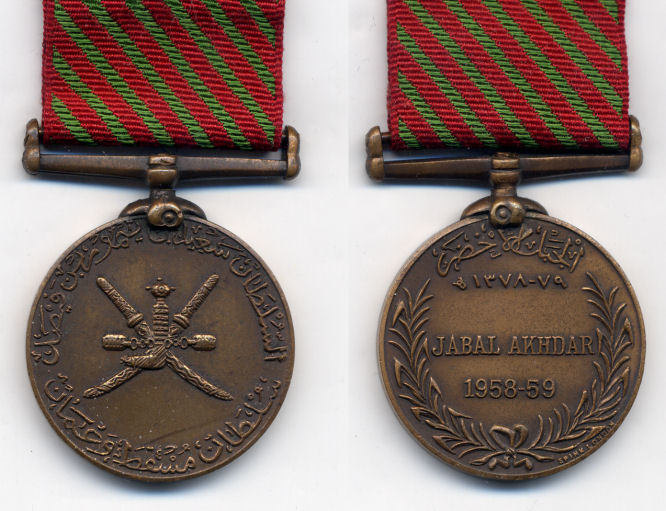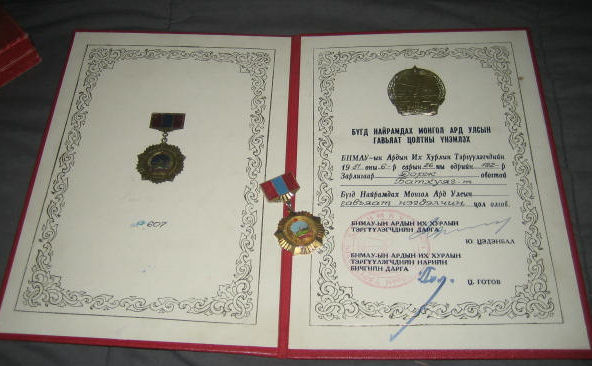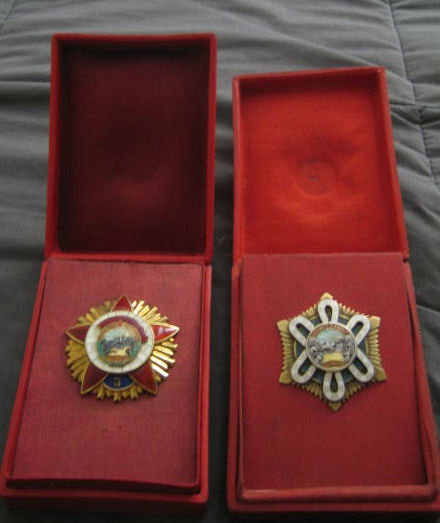-
Posts
14,343 -
Joined
-
Last visited
-
Days Won
25
Content Type
Profiles
Forums
Blogs
Gallery
Events
Store
Posts posted by Ed_Haynes
-
-
Just noticed this thread, sorry. Sometimes, it takes me a while . . .

The Omani medals for this campaign:
Midalit Al-Hamalat / The Campaign Medal -- Awarded to all officers and trained enlisted men (untrained personnel were excluded) who participated the the Jebel Akhdar War against the followers of Imam Ghalib bin Ali between 1 November 1958 and 1 February 1959. Established: By Sultan Said bin Taimur in 1959. Manufactured by Spink and Son (London, England). Obverse: A circular oxidized bronze medal. In the center, the Omani national emblem. Above and below, legends in Arabic. The medal is suspended from a swiveling straight-bar suspender (this is the only Omani medal to have aswiveling suspender). Bronze-gilt examples have been reported, but they seem to be merely trial or presentation specimens. Reverse: A wreath surrounding the lower two-thirds of the Medal. Above, a legend and, in the center "1378-79 H. [= 1958-59 C.E.]" and "JABAL AKHDAR / 1958-59". Ribbon: Diagonal stripes of green and red. This color scheme is said to represent the Jebel Akhdar (literally "Green Mountain") defanced with blood. The ribbon may be seen carrying a bronze (or silver?) khanjar device representing bravery in battle (essentially, a MiD).

 0
0 -
Yes. But there was still the Sino-Soviet tension; Europe was not the whole world for Soviet foreign policy. Maybe there was also the feeling was that Tsedenbal should have been happy with his Kutuzov 1st class, two Lenins, and an October Revolution? But what a waste making up that Honorary Freeman of the Mongolian People's Republic "Golden Star" Medal just for Brezhnev in 1974 if there was to be no reciprocity.
For the earlier era, Choibalsan's Suvorov 1st class, two Lenins, RSFSR Red Banner, and USSR Red Banner. Were probably seen as "enough" too for pre-Brezhnev goody-distribution?
0 -
And finally, for now, a documented item, with which I am very happy.
A documented Title of Merit (A8) set (type 2.1, 26 June 1981, #607). To Dorzh Bathuyag for excellent work in collective farms.
See: http://gmic.co.uk/index.php?showtopic=5056&st=14

 0
0 -
But no birthday giftie for poor little Tsedenbal . . .

 0
0 -
1- 80th Annniversary of the Revolution (B A56)
2- Champion of Socialist Competition (B X01, Type 1.2, #3761)

 0
0 -
Some Honorary Medals of Combat and Honorary Medals of Labor.
1- Honorary Medal of Combat (Type 1.2, #3390)
2- Honorary Medal of Combat (Type 2.3, #21118)
3- Honorary Medal of Labor (Type 1.1.2, #5596)
4- Honorary Medal of Labor (Type 1.2.1, #19393)

 0
0 -
Some low-quality images of some cased items. Some have been seen elsewhere here.
1- Order of the Red Banner of Military Valor "3" (#5)
2- A documented Order of the Polar Star (Type 3.1, 3 December 1955, #1217) - this is the document with, apparently, a "naighty" added-in photo - see http://gmic.co.uk/index.php?showtopic=4238&st=30 and following posts.

 0
0 -
Right, the one of the two Mongolian cosmonauts who actually went into space. I assume Shishkov & Muzalevsky are using a Russian version of his Mongolian name (which Battushig gets correct).
This HSU/Lenin was part of that whole "guest cosmonaut" program (that also included Sharma from India).
0 -
Hi Torsten,
You may have to change the name of the file or shrink it down a bit more. One thing about this forum, if I try to load a picture that is too large and resize it, I find that I need to give it a new name. There is some sort of persistent forum memory about file sizes, and it remember the old size. It can get frustrating at times.
When you get settled in, you may want to glance at my few DDR items:

Good luck,
Ed
0 -
Hi Michael, its a normal jpeg, 110kb and 750x525 pixels...is there a restriction on image sze for posting on this forum?? Cheers, Torsten.
Yeah, I usually resise to something like 666 (nothing Satanic, just easy to type) pixels for the largest dimension.
0 -
Ed,
I find it interesting that Rakesh Sharma of India received the Title HSU!! Shishkov, Vol.2, pg. 29 # 37.
 Doc
DocA cosmonaut award. The Soviets also received the Ashoka Chakra (which required special modifications to the notification for the award). Have been promised a chance to meet Sharma and photograph his medals when next in Bangalore.
0 -
Welcome, Torsten! We need more DDR experts here.
 0
0 -
Still not quite sure what you are counting. You say "British" but for something like the Southeast Asia , the operations (and the overwhelming majority of casualties) were Indian Army operations (the last under theoretical British command). Do you want Indian Army casualty figures included here (or for others?).
And we are counting killed only? Not died or wounded?
0 -
Hi Sam,
No the medal isn't named it's standard issue - the seller insisted it was his but of course you never can tell.
My next task is to find out when and where he was captured. I'm not aware of any publicly accessible POW lists for the second world war, is that an option? Otherwise, I'm pretty sure he would have been listed as captured in the Queen's Own Gazette, so when I get a chance I'll drive down the road to Maidstone and do some delving there.
Cheers,
Gilbert
The latest of the WWII POW lists has been reprinted in several volumes. Others are available (I have used them in the NAM, though I am sure copies exist elsewhere).
0 -
Thanks, Kim. It was, as I feared, a birthday present.
0 -
Put me down for one of each, should there ever be a revised, expanded, and ILLUSTRATED 2nd edition. Both signed, please.

 0
0 -
Right, Gilbert. Unless from a good auction house or a 100% reputable dealer, they aren't worth a second look. DNW did have a nice "John Chard" miniature pair a few sales back, with good provenance.
0 -
Intreresting. Sorry, I don't have the POW rolls for natives (of the British Isles).
0 -
And you are defining "British" as legally/ethnically British? (Gorkhas etc. excluded?)
0 -
Sorry Ed, the point is that the medal isn't the point! I was about to post the interesting stuff, his documents, then the baby woke up and my wife is on a business trip to the States (she's so selfish!).
Ok, here goes: Terence Thorpe-Woods was called up 1st September 1939 as an officer in 'A' Company, 5th Battalion the RWK's, at Bromley drill hall to be precise (this building is probably still standing, I will investigate)...
Oh, OK, I await, thanks . . . .

 0
0 -
Dear Ed,
the GDR (DDR) was established by german communists coming from Moscow: "Gruppe Ulbricht" & Co.
Best regards
Christian
And also by more generic anti-fascist Germans? -- but maybe those two populations were the same

No comment on who made up the BRD


 0
0 -
Unnamed? Do you have solid evidence thst it is his, and not Montgomery's?
0 -
I guess never relised or thought that there woud be anti NAZI partisans in side Germany

Yes, and where did you think the DDR came from??
 0
0 -
Thanks, Gerd!

Am told the family still has them all (except the Victory orders) . . .

 0
0




Oman
in Modern Campaigns and Conflicts
Posted · Edited by Ed_Haynes
Midalit Al-Khidmat Al-'Alamat / The General Service Medal -- Originally intended to serve as a multi-purpose Omani general service medal (along British lines), for service of at least six weeks with a unit of at least company size, the medal has to date only been awarded with one bar, for the Dhofar Rebellion. Despite apparent discussion to that effect, other bars have not been instituted, based on the principle that active service is part of the normal duty of Omani armed forces personnel. There is, for example, some suggestion that a bar was contemplated for the Second Gulf War. Awarded for suppression of the Dhofar rebellion led by the Dhofar Liberation Organization (created 1964) and the Popular Front for the Liberation of Oman and the Arab Gulf (PFLOAG, created 1964), later (in 1974) merged and renamed as the Popular Front for the Liberation of Oman (PFLO); these groups received assistance from the People's Democratic Republic of Yemen (PDRY or South Yemen). The Dohfar bar was awarded for fourteen days of consecutive service, thirty days of visits, or service abnormally terminated by wounds between 23 May 1965 and 20 June 1976 in those areas of the Dhofar Province and adjacent waters lying between longitude 52?00' and 56?30' E and latitude 16?30' and 18?00' N. Suppression assistance came to the Omani government from Iran, Jordan, and the United Kingdon and financial support came from India, Pakistan, Saudi Arabia, and the Trucial States (later, the United Arab Emirates). About 1971, the obverse of the medal was redesigned with the name and title of Sultan Qaboos. The die for the medal, with legends altered and the bar omitted, was used (at short notice) for the Accession Medal of Sultan Qaboos in 1970 (see below). Established: Struck by Spink & Son (London, England). Obverse: Circular, gilt, Omani coat of arms in the center. Inscription in Arabic above and, below; as these inscriptions differ for the various issues of the medal, they are detailed below. The medal is suspended from a straight-bar suyspender. The bar bears the name of the campaign in Arabic, "Dhofar"; so far, only this single bar seems to have been issued to this medal. Reverse: Mountains above laurel branches, Arabic inscription above. Ribbon: Equal of red, off-white, and green. The original ribbon design was intended to represent the three regiments of the Omani army: the Muscat Regiment (red), the Northern Frontier Regiment (green), and the Desert Regiment (sand), but there is also the interpretation that the colors represented blood, sand, and the green of the Jebel Akhdar region. When the ribbons were finally made, the sand-colored stripe came out very light, appearing - ironically and embarassingly - as if the ribbon represented the red-white-green colors of the opposing Dhofar Liberation Front. After Sultan Qaboos' accession to power, these colors were those used in the new Omani flag, so the embarsassment that ahd existed before was diminished. The ribbon of the Sultan Said medal may be seen carrying a bronze (or silver?) khanjar device or a bronze palm leaf representing bravery in battle. Awards: The medal was also awarded to Iranian and Jordanian troops who served in this campaign; this came in addition to their own national awards. British troops were not (officially) allowed to receive both this medal and their own Campaign Service Medal 1962 with "Dhofar" bar; many British officers on long-term loan to Oman did, however, opt for the Omani medal.
-- Sultan Said (1965-70) - with his name in the obverse inscription - very rare.
-- Sultan Qabus (1970-76) - with his name in the obverse inscription - the common variety. (This is the variety shown below.)